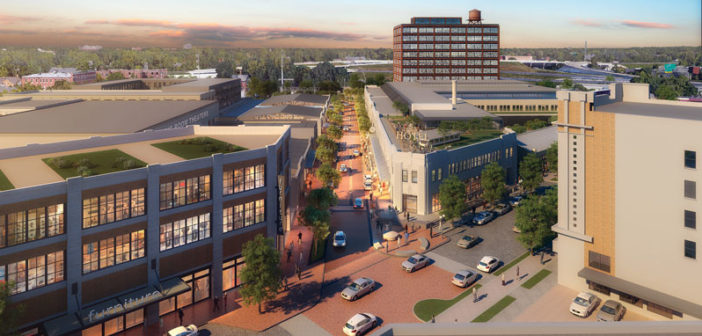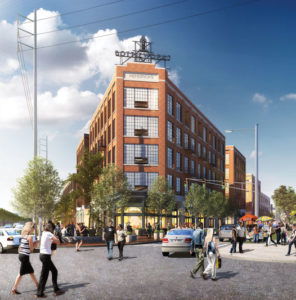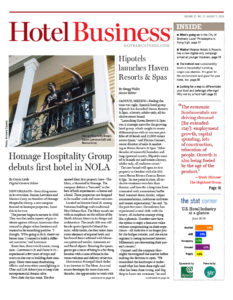INDIANAPOLIS—The historic Coca-Cola Bottling Company plant is getting a makeover in a big way. Known as Bottleworks District, the project, overseen by Hendricks Commercial Properties LLC, fuses the past and present to transform the site into a culinary, arts and entertainment hub for Hoosiers and visitors from all over the country.
“Although the Bottleworks District project is special due to the mere fact that it will be the reintroduction of a largely closed-off historic relic back into the public sphere, the project really goes beyond an homage to history and represents the future of sustainable, long-term-approach development. This is where many in the development world will be (and some are already) going: high-density mixed-use projects,” said Isaac Bamgbose, VP of Hendricks, a Beloit, WI-based full-service real estate development firm.
Situated on a 12-acre lot on Mass Ave., the $300-million adaptive-reuse project is the largest private development of its kind in Indiana. The idea behind the urban project is to transform the iconic Coca-Cola Bottling Plant, which was sold in 1969 to Indianapolis Public Schools (IPS), into a vibrant food hall (see Trend Watch, page 22) and entertainment hub. The facility has housed the IPS Service Center since 1971.
“It’s one thing to do mixed-use projects that include one or two uses, such as apartments and retail, or office and retail; it is another thing to bring together office, retail, apartments, hotel, entertainment, condos, a food hall and the arts together,” he said. “This site—given its size and location in the art/entertainment mecca of downtown Indianapolis—gives us that ability to confidently be able to deliver on bringing all those uses together successfully.”
As the project’s sole developer, the real estate development firm—which designed Bottleworks in collaboration with architecture firms Ratio Architects and Eppstein Uhen Architects—in 2017 began repurposing the site after an 18-month-long approval process. Prior to that, it took Hendricks nearly a year to secure the site (due to the RFP process).
“Given our extensive network in the field of development, retail, hospitality and our local Indianapolis connections, we were able to pool together the best talent and team to undertake this project,” Bamgbose said. “Our reputation has been key.”
Founded in 1974, the firm has a history of developing adaptive-reuse projects. “Whether it’s a tired shopping center in San Diego, a forgotten retail center on the Big Island in Hawaii, or a historic hotel building in the downtown of Beloit, WI—our hometown—it’s our passion to find diamonds in the rough and show the world their true potential,” he said. Hendricks considers the following when determining whether to take on adaptive-reuse projects, which, according to Bamgbose, is in the company’s DNA: location, and structural and visual integrity.
“There are competing mixed-use projects that require different needs,” he said. “It’s all about finding the right mix of amenities that will work for the Bottleworks District.”
Hendricks made it a point to preserve the building’s history and incorporate it into all design aspects. “We are reusing existing structures to reduce the carbon footprint of the development and to minimize the need for new materials,” he said. “We’ve also worked with officials at the local, state and federal level to meet with neighborhood and government approvals.” Additionally, parts of the site’s landscape will need to be modified.
“Many of the overhead power lines require relocation due to some new construction,” Bamgbose said. “We are reintroducing greenery and adding green space to the development when construction is completed. Part of the project includes cleaning up soil contamination, which will not only impact the site but the surrounding neighborhoods and groundwater quality.”
Bottleworks will have 180,000 sq. ft. of office space; residential options; and a 30,000-sq.-ft. community-focused marketplace. Slated to open in spring 2020, The Garage will occupy two of the bottling plant’s original garage buildings and host more than 25 F&B vendors. The food and market hall will feature 1930s Art Deco terracotta facades, industrial architecture and large, roll-up doors. There will also be a 150-room boutique property, which will occupy the majority of the bottling works administration building.
After considering other brands, including its own Ironworks brand, Hendricks settled on West Elm Hotels. “A mutual connection introduced us to West Elm Hotels, and we found that we connected very well—due to our long-term approach: They do not cut corners; their team has a hospitality background; there’s a mutual passion for historic buildings; and, ultimately, we both understand how special the Bottleworks District will be,” he said.
“Indianapolis was on our list of great cities to open a hotel in, and when we all first saw the building, we fell in love,” said David Bowd, principal at West Elm Hotels. “Historic renovations are very difficult, but the beauty in this building makes all the hard work worthwhile. It has so much character and an existing level of detail that I would say our renovation is as much restoration as anything else. The incredible design team at West Elm hotels, led by Peter Fowler, has really matched the new interiors to the historic nature of the building.”
West Elm made known its intentions of expanding into travel and hospitality in September 2016. Coined by the brand as a “network of locally managed properties,” West Elm Hotels revolves around three key tenets: wholehearted hospitality; distinctive, thoughtful design; and community connection. For every property under its brand, West Elm plans to showcase its top principles in design, programming and overall guest visit.
“When we launched West Elm Hotels, one of our goals was to have a mix of existing buildings and create and build new buildings,” he said.
This particular property will have glazed tiles on the walls and terrazzo floors throughout. “Like all West Elm Hotels, there will be very much a sense of place to our hotel, really embracing the neighborhood and Indianapolis as a whole,” Bowd said. “There will be great spaces to work, to meet, and to eat and drink.” The building’s width enables West Elm to develop large rooms and suites along with “stunning corridors and great lighting,” he said. The property will also have a restaurant and bar, a central atrium and room service.
Aimed at hiring as many locals as possible for the hotel launch, the West Elm Hotel Academy—a 10-week, 25-hour, intensive and immersive introduction to all facets of the hotel industry—is expected to launch in late 2019. “We have had wonderful mentors throughout our careers, and the West Elm Hotels Academy is a chance to give back to the industry we love,” he said. “It is designed to prepare potential staff for employment in the hospitality industry despite their age, or level of prior knowledge or experience.” There’s no cost to the applicant.
“The last one we did—we had more than 400 applicants and 160 people attended,” he said.
In addition to the mixed-use project in Indianapolis, West Elm has four hotels in the pipeline, located in Detroit; Minneapolis; Oakland, CA; and Portland, ME. “There are also a couple of very exciting projects we are working on that will be announced in the coming months,” he said. The hotel is slated to open in 2020.
“[Bottleworks District] is estimated to create more than 4,000 permanent and temporary jobs,” Bamgbose said. “Restoring the Coca-Cola plant back to its position of prominence will make the once vacant buildings thrive again. Hoosiers will soon be able to experience these iconic structures inside and out as our team puts in the work to restore and build beautiful, authentic structures.” HB





